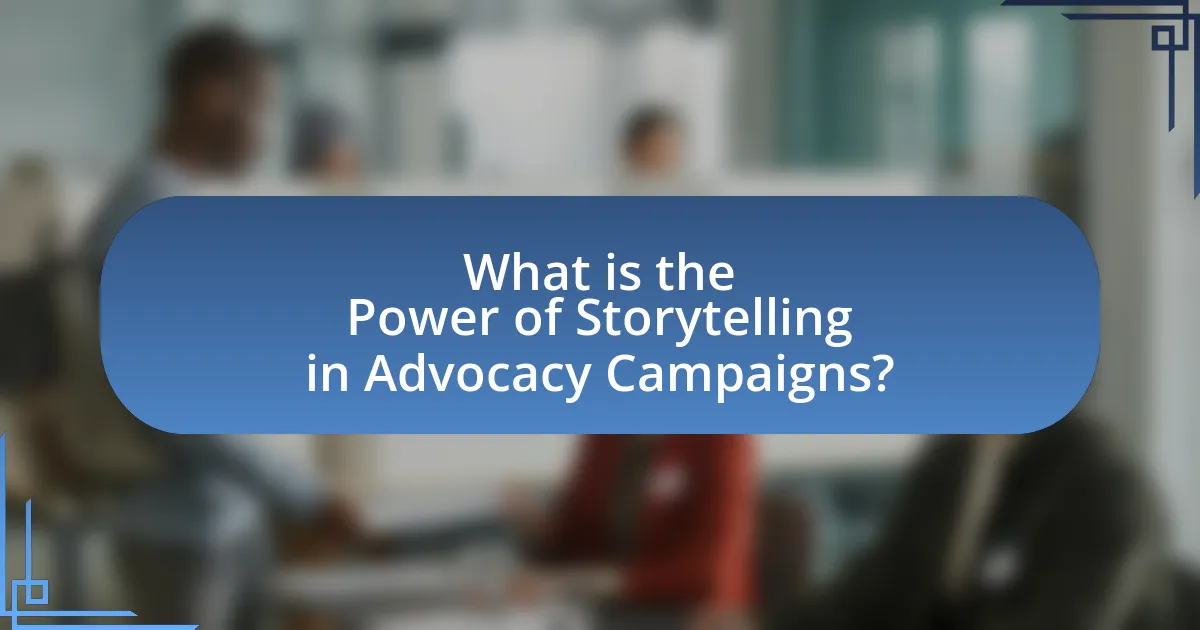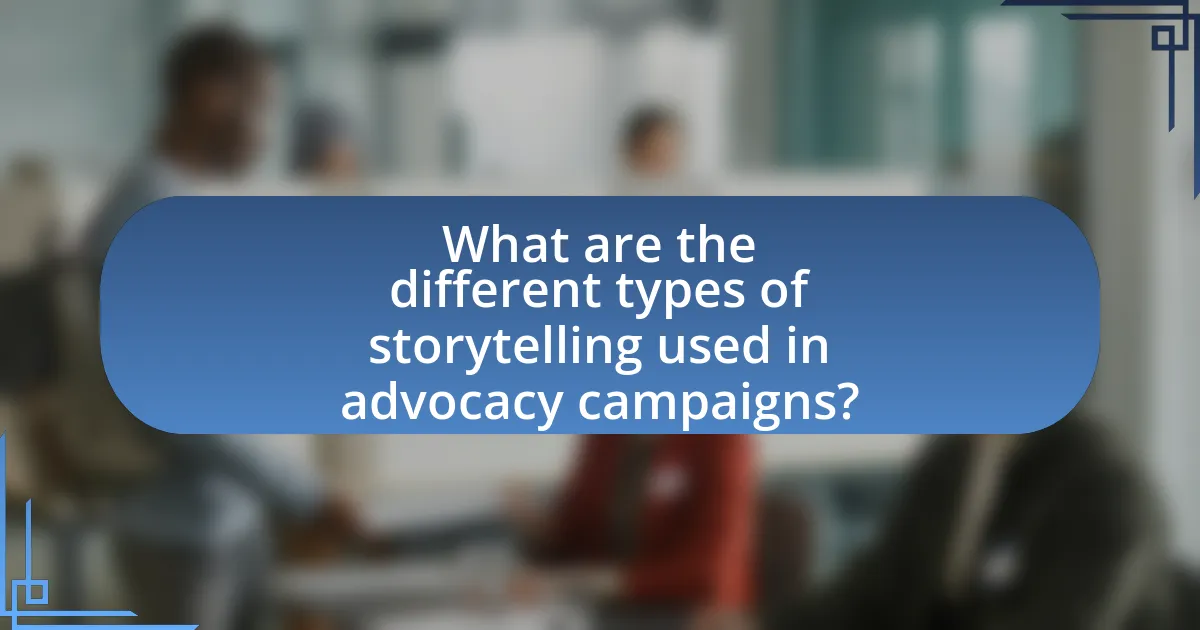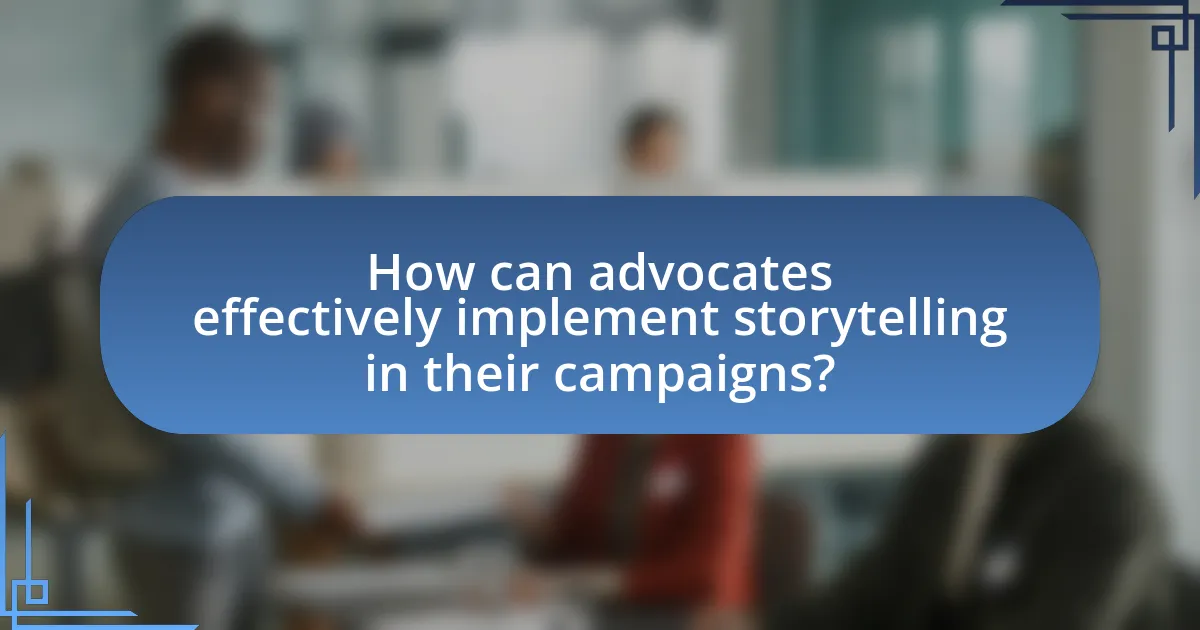The main entity of the article is the power of storytelling in advocacy campaigns. The article explores how storytelling creates emotional connections, enhances public perception, and drives engagement in advocacy efforts. It outlines key elements of effective storytelling, including clear messaging, emotional appeal, and relatable characters, while emphasizing the importance of emotional engagement in motivating action. Additionally, the article discusses various types of storytelling, such as personal narratives and data-driven stories, and highlights best practices for implementing storytelling strategies in advocacy campaigns, including measuring impact and ensuring authenticity.

What is the Power of Storytelling in Advocacy Campaigns?
The power of storytelling in advocacy campaigns lies in its ability to create emotional connections and drive engagement. Storytelling humanizes complex issues, making them relatable and memorable for the audience. Research indicates that narratives can increase information retention by up to 65%, as they allow individuals to visualize and empathize with the experiences of others. This emotional resonance can motivate action, as evidenced by campaigns like “It Gets Better,” which effectively used personal stories to combat bullying and support LGBTQ+ youth, resulting in increased awareness and community support.
How does storytelling influence public perception in advocacy?
Storytelling significantly influences public perception in advocacy by creating emotional connections that resonate with audiences. When advocates share personal narratives or compelling stories, they humanize complex issues, making them relatable and easier to understand. Research indicates that stories can increase empathy and engagement; for instance, a study published in the journal “Psychological Science” found that narratives can enhance the persuasiveness of messages by activating emotional responses in listeners. This emotional engagement often leads to a stronger commitment to the cause, as individuals feel more connected to the experiences being shared. Thus, effective storytelling not only informs but also motivates action, shaping public perception in favor of the advocacy efforts.
What are the key elements of effective storytelling in advocacy?
The key elements of effective storytelling in advocacy include a clear message, emotional connection, relatable characters, and a compelling narrative structure. A clear message ensures that the audience understands the core issue being addressed, while an emotional connection engages them on a personal level, making the story resonate. Relatable characters, often representing the affected individuals or communities, help the audience empathize with the situation. A compelling narrative structure, which typically includes a beginning, middle, and end, guides the audience through the story, creating a sense of urgency and prompting action. These elements collectively enhance the impact of advocacy efforts, as evidenced by successful campaigns that have mobilized public support and influenced policy changes.
How does emotional engagement enhance storytelling effectiveness?
Emotional engagement enhances storytelling effectiveness by creating a deeper connection between the audience and the narrative. When stories evoke emotions, they capture attention, foster empathy, and facilitate retention of information. Research indicates that emotionally charged stories are remembered more vividly than neutral ones; for instance, a study published in the journal “Cognitive Science” found that emotional content significantly improves memory recall. This connection not only makes the story more relatable but also motivates the audience to take action, which is particularly crucial in advocacy campaigns where the goal is to inspire change.
Why is storytelling a vital tool for advocates?
Storytelling is a vital tool for advocates because it effectively engages audiences and fosters emotional connections. By presenting issues through relatable narratives, advocates can illustrate the real-life impact of policies or social issues, making complex topics more accessible. Research indicates that stories can increase information retention by up to 65%, as they resonate on a personal level, prompting empathy and action. This emotional engagement is crucial in advocacy, as it motivates individuals to support causes and drives social change.
What role does storytelling play in building community support?
Storytelling plays a crucial role in building community support by fostering emotional connections and shared identities among individuals. When narratives resonate with community values and experiences, they create a sense of belonging and motivate collective action. Research indicates that stories can increase empathy and understanding, making complex issues more relatable; for instance, a study published in the journal “Science” found that narratives can significantly enhance the persuasiveness of messages by engaging listeners on an emotional level. This emotional engagement is essential for mobilizing community members around common goals and initiatives, ultimately strengthening community ties and support for advocacy campaigns.
How can storytelling drive action and mobilize supporters?
Storytelling can drive action and mobilize supporters by creating emotional connections that inspire individuals to engage with a cause. When narratives are crafted to highlight personal experiences or collective struggles, they resonate with audiences, making the issues more relatable and urgent. Research indicates that stories can increase empathy and understanding, leading to a higher likelihood of individuals taking action, such as donating, volunteering, or advocating for change. For instance, a study published in the journal “Psychological Science” found that narratives significantly enhance the persuasiveness of messages, demonstrating that well-told stories can effectively motivate people to support social causes.

What are the different types of storytelling used in advocacy campaigns?
Advocacy campaigns utilize various types of storytelling to effectively communicate their messages and engage audiences. The primary types include personal narratives, which share individual experiences to evoke empathy; data-driven stories, which present statistics and research to support claims; and collective stories, which highlight community experiences to foster a sense of belonging and shared purpose. Each type serves to connect emotionally with the audience, making the campaign’s message more relatable and impactful. For instance, personal narratives can humanize complex issues, while data-driven stories provide credibility and urgency, as seen in campaigns addressing climate change that combine personal testimonies with scientific data to drive action.
How do personal narratives impact advocacy efforts?
Personal narratives significantly enhance advocacy efforts by fostering emotional connections and increasing relatability among audiences. When individuals share their personal experiences related to a cause, they humanize complex issues, making them more accessible and compelling. Research indicates that stories can evoke empathy and motivate action; for instance, a study published in the journal “Psychological Science” found that narratives can lead to greater engagement and support for social issues compared to statistical data alone. This emotional resonance encourages individuals to advocate for change, mobilizing communities and influencing policy decisions.
What are the benefits of using testimonials in campaigns?
Using testimonials in campaigns enhances credibility and builds trust with the audience. Testimonials provide social proof, demonstrating that real customers have had positive experiences with a product or service, which can significantly influence potential buyers’ decisions. According to a study by Nielsen, 92% of consumers trust recommendations from individuals over brands, highlighting the effectiveness of testimonials in shaping perceptions. Additionally, testimonials can evoke emotional responses, making the campaign more relatable and impactful, thereby increasing engagement and conversion rates.
How can data-driven storytelling enhance credibility?
Data-driven storytelling enhances credibility by providing empirical evidence that supports claims and narratives. When stories are backed by data, such as statistics or research findings, they become more persuasive and trustworthy to the audience. For instance, a study published in the Journal of Marketing Research found that narratives combined with data significantly increased the perceived credibility of the information presented. This combination allows advocates to build a stronger case, as audiences are more likely to trust information that is substantiated by factual data, leading to greater engagement and impact in advocacy campaigns.
What role does visual storytelling play in advocacy?
Visual storytelling plays a crucial role in advocacy by enhancing emotional engagement and facilitating understanding of complex issues. It allows advocates to convey messages through compelling images, videos, and graphics, which can evoke empathy and drive action more effectively than text alone. Research indicates that visuals can increase information retention by up to 65%, making them a powerful tool for communicating urgent social issues. For instance, campaigns like “Save the Children” utilize impactful imagery to highlight the plight of children in crisis, successfully mobilizing public support and donations.
How can images and videos amplify the message of advocacy campaigns?
Images and videos amplify the message of advocacy campaigns by creating emotional connections and enhancing message retention. Visual content engages audiences more effectively than text alone, as studies show that people process images 60,000 times faster than words. Furthermore, according to a report by the Content Marketing Institute, visual storytelling can increase engagement rates by up to 94%. This heightened engagement leads to greater awareness and action, making advocacy campaigns more impactful.
What are the best practices for creating compelling visual stories?
The best practices for creating compelling visual stories include focusing on a clear narrative, utilizing strong visuals, and engaging the audience emotionally. A clear narrative provides structure, guiding viewers through the story with a beginning, middle, and end, which enhances understanding and retention. Strong visuals, such as high-quality images and graphics, capture attention and convey messages quickly, as studies show that visuals are processed 60,000 times faster than text. Engaging the audience emotionally is crucial; research indicates that emotional connections can significantly increase message impact and recall. By combining these elements, visual stories can effectively advocate for causes and resonate with audiences.

How can advocates effectively implement storytelling in their campaigns?
Advocates can effectively implement storytelling in their campaigns by crafting narratives that resonate emotionally with their audience. This involves identifying relatable characters, presenting a clear conflict, and showcasing a resolution that aligns with the campaign’s goals. Research indicates that stories can increase engagement and retention of information; for instance, a study published in the “Journal of Marketing Research” found that narratives can enhance persuasion by up to 22 times compared to non-narrative formats. By utilizing personal anecdotes and real-life examples, advocates can create a compelling connection that motivates action and fosters empathy, ultimately driving the campaign’s message home.
What strategies can be used to craft a compelling advocacy story?
To craft a compelling advocacy story, utilize strategies such as personal narratives, emotional appeal, and clear messaging. Personal narratives engage audiences by sharing relatable experiences, making the issue more tangible. Emotional appeal connects with the audience’s feelings, fostering empathy and urgency. Clear messaging ensures that the core message is easily understood and memorable, which is crucial for effective advocacy. Research indicates that stories that evoke emotions can increase persuasion by up to 50%, highlighting the importance of these strategies in advocacy storytelling.
How can advocates identify their target audience for storytelling?
Advocates can identify their target audience for storytelling by conducting thorough audience research, which includes analyzing demographics, interests, and behaviors. This process involves utilizing tools such as surveys, social media analytics, and focus groups to gather data on potential audience segments. For instance, a study by the Pew Research Center found that understanding the specific interests and values of different demographic groups can significantly enhance engagement in advocacy campaigns. By segmenting the audience based on these insights, advocates can tailor their narratives to resonate more effectively, ensuring that the storytelling aligns with the audience’s experiences and motivations.
What techniques can enhance the relatability of advocacy stories?
Techniques that can enhance the relatability of advocacy stories include using personal narratives, incorporating emotional appeals, and employing relatable characters. Personal narratives allow audiences to connect with the storyteller’s experiences, making the message more impactful. Emotional appeals, such as evoking empathy or compassion, can resonate deeply with the audience, prompting them to engage with the cause. Additionally, relatable characters, who reflect the audience’s values or experiences, can foster a sense of identification, making the story more compelling. Research indicates that stories featuring personal experiences and emotional connections are more likely to influence attitudes and behaviors, as demonstrated in studies on narrative persuasion.
What are common pitfalls to avoid in storytelling for advocacy?
Common pitfalls to avoid in storytelling for advocacy include oversimplification, lack of authenticity, and failure to connect emotionally with the audience. Oversimplification can lead to a distorted understanding of complex issues, as seen in campaigns that reduce multifaceted problems to single narratives, which can mislead the audience. Lack of authenticity undermines credibility; for example, stories that feel contrived or insincere can alienate potential supporters. Additionally, failing to connect emotionally can result in disengagement; research indicates that emotionally resonant stories are more likely to inspire action and support, as demonstrated in studies by the FrameWorks Institute, which highlight the importance of emotional engagement in effective advocacy storytelling.
How can advocates ensure authenticity in their narratives?
Advocates can ensure authenticity in their narratives by grounding their stories in real experiences and factual evidence. This involves using personal testimonies, verified data, and credible sources to support their claims, which enhances trustworthiness. For instance, a study by the Stanford Social Innovation Review highlights that narratives based on genuine experiences resonate more with audiences, leading to increased engagement and support for advocacy efforts. By prioritizing transparency and accuracy, advocates can create compelling narratives that reflect true experiences and foster deeper connections with their audience.
What are the risks of oversimplifying complex issues in storytelling?
Oversimplifying complex issues in storytelling can lead to misrepresentation and misunderstanding of the subject matter. When narratives reduce multifaceted topics to simplistic terms, they often ignore critical nuances and context, which can result in audiences forming inaccurate perceptions. For instance, a study by the Pew Research Center found that oversimplified narratives about immigration often fail to capture the economic and social complexities involved, leading to polarized opinions based on incomplete information. This misrepresentation can hinder informed decision-making and perpetuate stereotypes, ultimately undermining the effectiveness of advocacy campaigns aimed at fostering understanding and change.
What are the best practices for measuring the impact of storytelling in advocacy campaigns?
The best practices for measuring the impact of storytelling in advocacy campaigns include setting clear objectives, utilizing qualitative and quantitative metrics, and gathering feedback from the target audience. Clear objectives allow organizations to define what success looks like, such as increased awareness or engagement. Qualitative metrics, such as interviews and focus groups, provide insights into emotional responses, while quantitative metrics, like surveys and social media analytics, offer measurable data on reach and engagement levels. Gathering feedback directly from the audience helps assess the effectiveness of the storytelling approach and informs future campaigns. For example, a study by the Stanford Social Innovation Review found that narratives significantly increased engagement and retention of information, demonstrating the importance of effective storytelling in advocacy.
How can advocates track engagement and response to their stories?
Advocates can track engagement and response to their stories by utilizing analytics tools and social media metrics. These tools provide data on likes, shares, comments, and overall reach, allowing advocates to measure audience interaction. For instance, platforms like Facebook and Twitter offer insights into post performance, showing how many users engaged with a story. Additionally, surveys and feedback forms can be employed to gather qualitative responses directly from the audience, providing deeper insights into their perceptions and emotional reactions. This combination of quantitative and qualitative data enables advocates to assess the effectiveness of their storytelling in advocacy campaigns.
What metrics are most effective for evaluating storytelling success?
The most effective metrics for evaluating storytelling success include audience engagement, emotional impact, and conversion rates. Audience engagement can be measured through metrics such as social media shares, comments, and likes, indicating how well the story resonates with the audience. Emotional impact can be assessed through surveys or feedback forms that gauge the audience’s feelings and reactions to the story, providing insight into its effectiveness in evoking emotions. Conversion rates, which track the number of individuals taking a desired action after engaging with the story, such as signing a petition or donating, serve as a direct measure of the story’s influence on behavior. These metrics collectively provide a comprehensive evaluation of storytelling success in advocacy campaigns.


